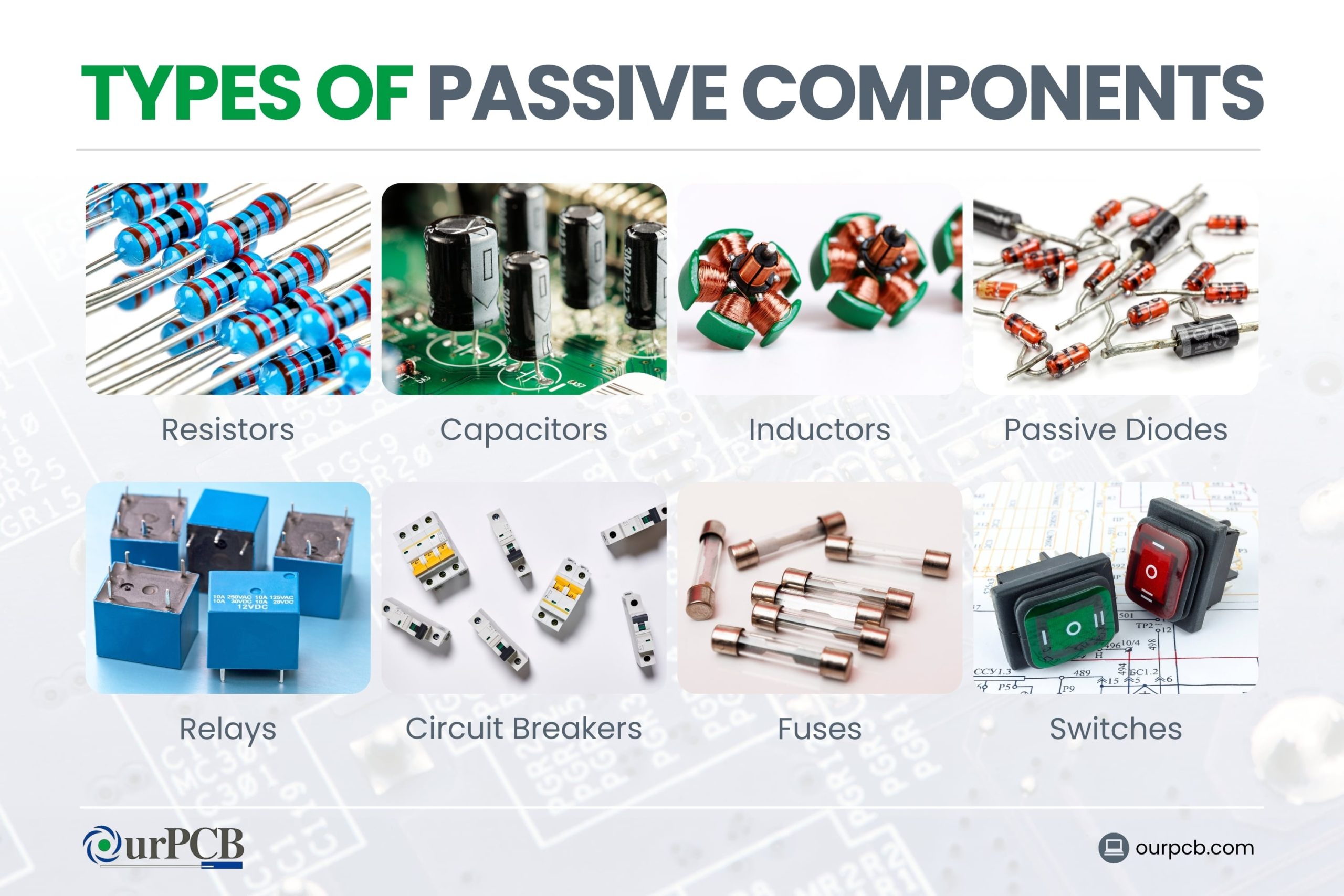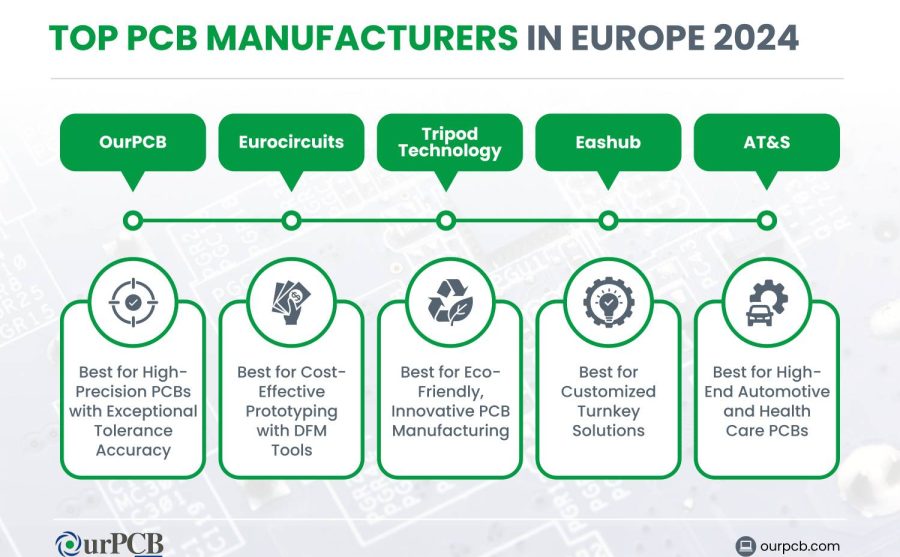While you can come to OurPCB for help designing electronic circuit boards, learning the basics of electronic components is a skill everyone can learn. Once you understand how to control the flow of electric current in the circuit, you can create effective PCB designs of your own.
Contents
- What is an Electronic Component?
- Active Electronic Components
- Passive Electronic Components
- How Do Electronic Circuit Components Work Together?
- Basic Circuitry
- Examples of Simple Circuits
- Basic of Electronic Components FAQs
- What are the advantages of using Integrated Circuits (ICs)?
- Can passive components modify electrical signals?
What is an Electronic Component?
An electronic component is a basic part used to control the flow of electricity. These parts come in many shapes and sizes, each with a specific function. They can be found in almost all electronic devices, from flashlights to complex systems like computers.
Electronic components work together to perform tasks like amplifying signals, storing data, or converting energy. Understanding these components is the first step to learning how electronic devices operate and are built.
Active Electronic Components
Active components are parts that need an external power source to work. They can control the flow of electricity, amplify signals, or switch it on and off.

Transistors
Transistors are semiconductor devices that can amplify or switch electronic signals and electrical power. They work by using a small input current to control a larger output current and are used in amplifiers, switches, and signal modulators. Transistors are used in devices like hearing aids, computer memory chips, and smartphones.
Types of Transistors
- Bipolar junction transistors (BJT) have three layers of semiconductor material and can amplify current. They come in NPN and PNP varieties, with NPN being more common due to easier manufacturing.
- Field-effect transistors (FET) control the flow of current by applying a voltage to an electric field. They include Junction FETs (JFETs) and Metal-Oxide-Semiconductor FETs (MOSFETs). MOSFETs are widely used for their efficiency and low power consumption.
Integrated Circuits (ICs)
Integrated Circuits (ICs) are like miniature circuit boards, packing many components into a single tiny chip. They can perform complex functions like processing signals, storing data, or controlling other devices.
Types
- Analog ICs handle continuous signals and are used in audio and radio frequency applications.
- Digital ICs handle binary signals and are used in computers and digital systems.
- Mixed-Signal ICs combine both analog and digital functions on a single chip.
Active Diodes
Active diodes, also known as active rectifiers or synchronous rectifiers, use additional components like transistors or MOSFETs to improve performance. These components need an external power source to operate.
Types of Diodes
- Light-emitting diodes (LED) emit light when current passes through them.
- Zener diodes allow current to flow in reverse direction when a specific voltage is reached.
- Schottky diodes are known for their low forward voltage drop and fast switching.
Vacuum Tubes
Vacuum tubes control electric current flow in a high vacuum between electrodes and were an early form of electronic amplifier and switch.
Vacuum tubes were once widely used in radios, televisions, and other electronics, but have mostly been replaced by transistors and ICs. However, they’re still used in some high-end RF transmitters, audio amplifiers, and specialized scientific equipment.
Types of Vacuum Tubes
- Triodes have three electrodes and can amplify signals.
- Tetrodes have four electrodes, reducing interference in amplification.
- Pentodes have five electrodes, offering improved amplification.
Special Offer: Get $100 off your order!
Email [email protected] to get started!
Passive Electronic Components
Passive components don’t need an external power source to function. They can’t amplify signals, but they can store energy or resist the flow of electricity. These parts help shape and manage the signals within electronic devices.


Resistors
Resistors limit or control the flow of electrical current in a circuit, like a kink in a hose reducing water flow. They’re used to set voltage levels, divide voltages, and limit current to protect other components.
Types of Resistors
- Fixed resistors have a set resistance value.
- Variable resistors allow for adjustment of resistance.
Capacitors
Capacitors store electrical energy in an electric field and can release it quickly when needed. They’re used for filtering, smoothing, and timing circuits. Capacitors are used in power supplies, audio circuits, radio tuners, and many other applications.
Types of Capacitors
- Ceramic capacitors use a ceramic material as the dielectric and are mostly used in high-frequency applications.
- Electrolytic capacitors have a larger capacitance and are used in low-frequency applications.
- Tantalum capacitors are known for their reliability and stability in small sizes.
Inductors
Inductors store energy in a magnetic field when electrical current flows through them. They’re found in power supplies, radio circuits, motors, and other applications where filtering or energy storage is needed.
Types of Inductors
- Fixed inductors have a set inductance value, used in applications like filters and chokes.
- Variable inductors allow for adjustment of inductance, used in tuning circuits.
Passive Diodes
Passive diodes are semiconductor devices that allow current to flow in only one direction. They don’t generate or amplify power; they only control the direction of existing current flow.
What makes them different from active diodes is that passive diodes don’t need an external power source to operate.
Types of Passive Diodes
- Standard rectifier diodes are the most basic type of diode, primarily used to convert alternating current (AC) to direct current (DC). They allow current to flow in one direction while blocking it in the opposite direction.
- Zener diodes allow current to flow in the reverse direction when a specific breakdown voltage is reached. This is used for voltage regulation to maintain a stable output voltage in power supplies.
- Schottky diodes have a low forward voltage drop and fast switching speeds. They’re commonly used in high-speed switching applications and for reducing power loss in power supplies.
- Light-emitting diodes (LEDs) emit light when current flows through them and are used as indicator lights and in display technologies.
- Photodiodes convert light into electrical current. Often used in light detection applications, like solar cells and optical communication systems.
Relays
Relays are electrically operated switches that can control a high-current or high-voltage circuit with small control signals. They are used in industrial control systems, automotive applications, and many other areas where electrical isolation or high-power switching is needed.
Types of Relays
- Electromechanical relays use moving parts to open or close the circuit.
- Solid-state relays use electronic components without moving parts, offering faster switching and longer life.
Circuit Breakers
Circuit breakers protect circuits from damage caused by overcurrent or short circuits. They automatically interrupt the flow of current when it exceeds a safe level.
Types of Circuit Breakers
- Miniature circuit breakers (MCB) protect against overload and short circuits in small-scale applications.
- Molded case circuit breakers (MCCB) protect larger-scale industrial applications.
Fuses
Fuses are sacrificial devices that protect circuits by melting when the current exceeds a safe level. They’re designed to be replaced once they’ve blown. Fuses are used in electronics, automotive circuits, and household appliances for overcurrent protection.
Types of Fuses
- Cartridge fuses are cylindrical in shape and used in various applications.
- Blade fuses are commonly used in automobiles.
- Resettable fuses automatically reset after the fault is cleared.
Switches
Switches are used to open or close electrical circuits, controlling the flow of current.
Types of Switches
- Toggle switches are operated by a lever.
- Push button switches are activated by pressing a button.
- Rotary switches are operated by rotating a knob.
How Do Electronic Circuit Components Work Together?
Basic Circuitry
In a basic electronic circuit, different components work together to perform specific functions. Here are the three fundamental parts of a basic circuit:
- Voltage Source: The voltage source provides the necessary power for the circuit. It can be a battery for DC circuits or a power supply for AC circuits. The voltage source creates a potential difference that drives the current through the circuit.
- Conductive Path: This is the route through which the current flows, usually made of copper wires or traces on a printed circuit board (PCB). Conductive paths link various components, allowing current to travel from one component to another.
- Load: The load is the component that consumes power and performs work, like a light bulb, motor, or speaker. The load converts electrical energy into other forms of energy, such as light, sound, or motion.
Examples of Simple Circuits
LED Circuit
In this circuit, a resistor is connected in series with the LED and the power source. When the circuit is closed, current flows from the power source through the resistor, limiting the current to a safe level for the LED, which then emits light.
- LED: The light-emitting diode, which lights up when current flows through it.
- Resistor: Limits the current to prevent damaging the LED.
- Power Source: Provides the necessary voltage for the LED to operate.
Amplifier Circuit
In a common emitter amplifier, the input signal is fed into the base of a transistor through a coupling capacitor. The transistor amplifies this signal, and the amplified output is taken from the collector, passing through another capacitor to block any DC component.
An amplifier circuit includes:
- Transistor which acts as the main amplifying component.
- Resistors and capacitors control the voltage and current levels, stabilize the circuit, and filter signals.
Oscillator Circuit
In an LC oscillator, the frequency of oscillation is determined by an inductor and capacitor forming a tank circuit. The transistor amplifies these oscillations, resulting in a stable output signal.
One example of this is the Colpitts oscillator, which uses a capacitive voltage divider for feedback. This design allows it to operate at very high frequencies, making it suitable for applications like radio frequency transmitters.
An oscillator circuit generates a continuous, oscillating signal (like a sine wave). It includes:
- An amplifier (transistor or op-amp) provides the necessary gain to overcome losses and sustain oscillation.
- The feedback network determines the frequency of oscillation, often using a combination of resistors and capacitors or inductors and capacitors to create a resonant circuit.
- Frequency-determining components (inductors and capacitors) are specific components within the feedback network that set the exact frequency of the output signal.
If you need any more assistance with electronic components, get in touch with our experienced team at OurPCB. We’d love to help!
Basic of Electronic Components FAQs
What are the advantages of using Integrated Circuits (ICs)?
Integrated circuits offer significant advantages, including smaller size, lower cost, higher reliability, and better performance compared to discrete components.
Can passive components modify electrical signals?
Yes, passive components can modify electrical signals. They can attenuate signals, introduce phase shifts, or filter out specific frequencies without needing an external power source. They cannot amplify electrical signals.
Back to top: Basics of Electronic Components
Special Offer: Get $100 off your order!
Email [email protected] to get started!








